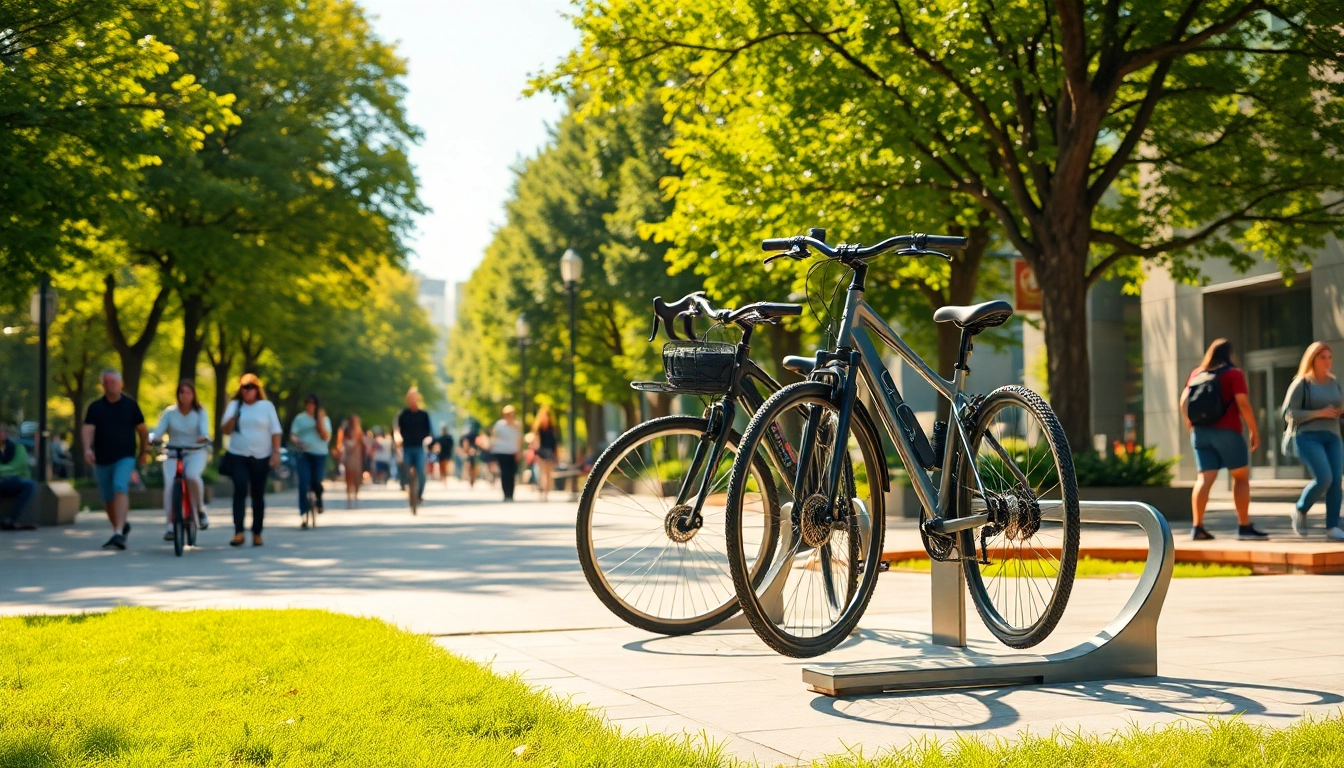Understanding the Importance of a Designer Bike Rack
As urban environments continue to evolve, the need for sustainable transportation solutions has become increasingly critical. Among these solutions, cycling stands out as an eco-friendly mode of transport that offers numerous benefits, such as reducing carbon emissions, alleviating traffic congestion, and promoting healthier lifestyles. However, for cycling to become an appealing option, the infrastructure must be in place, and one significant component of this infrastructure is the Designer bike rack. These bike racks are not just functional; they combine practicality with aesthetic appeal, fostering a culture of cycling within communities.
Creating Functional and Aesthetic Spaces
When designing urban spaces, the balance between functionality and aesthetics is paramount. Designer bike racks serve as more than mere utilitarian objects; they can enhance the visual appeal of public areas, making them attractive to both cyclists and pedestrians. When thoughtfully integrated into the environment, these bike racks complement architecture, landscaping, and the overall urban design aesthetics.
Aesthetically pleasing bike racks can encourage more people to adopt cycling as their preferred mode of transportation. When individuals see attractive and well-placed bike racks, they are more likely to engage with the space and utilize the cycling facilities available to them. This approach can lead to increased cycling uptake, diminishing the prevalence of vehicles on the roads and subsequently contributing to a decrease in urban pollution.
The Role of Design in Bicycle Parking Solutions
Design plays a pivotal role in the effectiveness of bike parking solutions. The layout, style, and material of bike racks can considerably impact their usability and popularity. For example, a well-designed bike rack allows for easy access and secure locking options, which is essential for encouraging bike usage.
Moreover, innovative designs that offer various locking mechanisms can cater to different types of bicycles, whether they be road bikes, mountain bikes, or electric bicycles. Unique design elements, such as integrated seating or solar-powered lighting in bike racks, can further enhance functionality, making cycling more appealing and accessible.
Enhancing Community Engagement Through Style
Communities that invest in stylish and thoughtfully placed bike racks can significantly enhance civic engagement. When people notice well-designed infrastructure, it creates pride and a sense of ownership within the community. Furthermore, incorporating local art or community themes into the design of bike racks can create a deeper connection between residents and their environment.
Designer bike racks can serve as public art installations that tell a story or represent local culture. This artistic expression not only beautifies the urban landscape but also engages residents and tourists alike, making the community more vibrant and inviting. Ultimately, when communities prioritize stylish infrastructure, they promote not just cycling but also social interactions and connections among residents.
Types of Designer Bike Rack Designs
Modern and Minimalist Styles
Modern and minimalist designs are a popular choice for many urban planners and businesses because they resonate well with current architectural trends. The sleek lines and simplistic forms of these designs often present a clutter-free look, making them suitable for various environments, from busy urban centers to quiet residential areas.
Minimalist bike racks occupy less space and offer straightforward functionality, which appeals to a broad audience. These racks typically feature smooth surfaces and are made from materials such as stainless steel or powder-coated metal, which offer durability while maintaining aesthetic value. The design’s simplicity often makes installation straightforward, allowing for flexibility in placement.
Themed and Artistic Designs
Themed and artistic designer bike racks are an excellent method for branding and local identity expression. Communities can utilize creative designs shaped like animals, landmarks, or abstract art to showcase local culture, history, or geography. These unique offerings can transform a standard bike rack into a conversation piece, inviting residents and visitors to engage further with the area.
Additionally, themed bike racks can serve practical purposes. For instance, bicycle racks shaped like trees provide not only functional parking but also shade for waiting cyclists during hot weather. Such creativity encourages the melding of art and functionality, further promoting cycling as a preferred mode of transport in urban settings.
Custom Solutions for Unique Needs
Not all communities have the same requirements when it comes to bike parking. Custom-designed bike racks allow for a variety of functionalities to accommodate different needs. Local businesses may require bike racks that reflect their brand’s aesthetics or specific formats to fit into limited spaces.
Custom solutions can include features such as integrated signage for promotional purposes, modular designs that can be expanded or reconfigured, or racks that incorporate smart technologies like bike-tracking systems. Working closely with designers can help communities arrive at a solution that meets their unique demands while further enhancing the local landscape.
Material and Durability Considerations
Choosing the Right Materials for Outdoor Use
The durability of a designer bike rack is as important as its design. When selecting materials for outdoor use, it’s crucial to consider weather resistance, corrosion potential, and overall longevity. Common materials for bike racks include steel, aluminum, and concrete. Each of these materials has its own benefits and challenges.
Steel, for example, is incredibly strong and can withstand heavy usage. However, it may require additional coating or treatment to prevent rust when exposed to moisture. On the other hand, aluminum is lightweight and resists corrosion but may not offer the same level of durability as steel. Additionally, concrete can provide an element of permanence but lacks the flexibility of other materials in terms of design and aesthetics.
Weather Resistance and Longevity
Weather resistance is a critical consideration when selecting materials for bike racks, as they are often subject to rain, snow, UV radiation, and other environmental factors. Choosing high-quality finishes and coatings can significantly extend the lifespan of a bike rack.
For instance, powder coating is a popular option that adds a layer of protection against rust and scratching, while also offering a beautiful finish in various colors. Additionally, using stainless steel can provide an appealing aesthetic and robust resistance to corrosion, ensuring longevity even in harsh weather conditions.
Maintenance Tips for Lasting Aesthetic
To maximize the lifespan of a designer bike rack, regular maintenance is essential. It’s advisable to periodically inspect bike racks for any signs of wear or damage. Maintenance can include cleaning the surface to remove dirt and debris, checking for rust or corrosion, and applying protective coatings as needed.
Incorporating regular checks into a community maintenance schedule ensures aesthetics and functionality are preserved over time. Furthermore, communities can establish awareness programs about maintaining bike racks in park or public spaces, encouraging residents to take part in the upkeep of their shared facilities.
Installation and Placement Best Practices
Optimal Locations for Designer Bike Racks
Correct installation of designer bike racks is crucial for optimizing their utility and enhancing community engagement. The locations chosen should be strategic, easily accessible, and close to popular destinations such as public transportation hubs, shops, parks, and community centers.
Visibility plays a significant role in usage; bike racks should be located in well-lit and trafficked areas to deter theft and vandalism. Additionally, creating a network of bike racks spaced adequately across the community can encourage cycling as a primary mode of transportation.
Installation Methods to Consider
Installation methods may vary according to the design and materials of the bike rack. Standard methods include bolting bike racks to the ground, using concrete footings for heavy models, or employing removable options that allow for flexibility in placement during different seasons or events.
Understanding local installation regulations and guidelines is crucial for ensuring compliance and optimizing safety. Community planners should collaborate with contractors who have experience in installing similar infrastructure to ensure durability and adherence to local standards.
Compliance with Local Regulations
Ensure adherence to local regulations and zoning laws before installation. This step is essential to prevent possible legal challenges or complaints from community members. Many regions have specific requirements regarding the distance bike racks must be from sidewalks, buildings, or other structures.
Consulting with local authorities may provide insights into necessary permits, safety regulations, and optimal design practices that align with city plans. This cooperative approach will help create harmonious integration of bike racks into the urban landscape, facilitating both compliance and functionality.
Maximizing the Benefits of Your Designer Bike Rack
Incentivizing Cycling Through Design
Strategically designed bike racks not only serve as functional components of cycling infrastructure but also act as incentives for cycling. Their aesthetic appeal can draw attention, encouraging more people to consider cycling as a viable form of transportation. In community events, highlighting designer bike racks can be an excellent promotional tool, showcasing the community’s commitment to sustainable transport solutions.
Offering rewards or discounts for cyclists who use specific bike racks can further encourage cycling. Partnerships with local businesses may enable initiatives that benefit both cyclists and businesses, creating a cycle of support and growth in community cycling culture.
Integrating with Landscaping and Urban Planning
Incorporating designer bike racks into landscaping and urban planning helps create cohesive and welcoming spaces. Collaborating with landscape architects during the design phase ensures that bike racks complement the overall aesthetic of parks and public areas.
Utilizing greenery, walkways, and public art in conjunction with bike racks creates an inviting environment for cyclists and pedestrians. This design approach emphasizes the importance of cohesive urban planning strategies in enhancing the overall cycling experience and fostering community connections.
Measuring the Impact on Community Engagement
The effectiveness of designer bike racks should be measurable to ensure that they successfully encourage cycling and community engagement. Implementing tracking methods, such as bike counters or anecdotal feedback, can provide insights into usage patterns and help assess whether the installations meet the community’s needs.
Regular evaluations can help communities understand how well their cycling infrastructure is functioning and identify areas that require improvement. By embracing a data-driven approach to the design and placement of bike racks, communities can continuously refine their strategies to enhance cycling and community engagement further.


